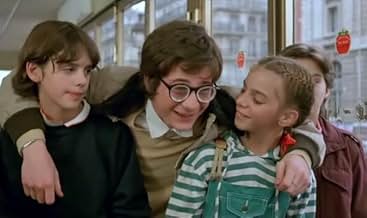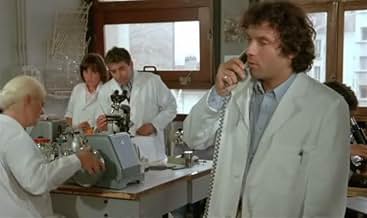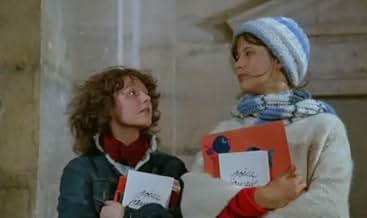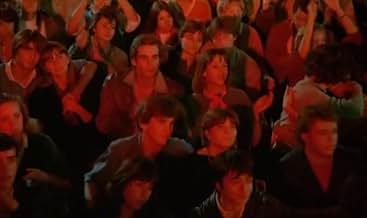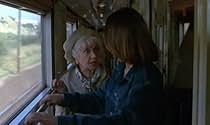La boum 2
- 1982
- 1h 49min
CALIFICACIÓN DE IMDb
6.2/10
5.5 k
TU CALIFICACIÓN
Agrega una trama en tu idiomaVulnerable and impressionable teenage girl continues to experience sorrows and joys of adult life.Vulnerable and impressionable teenage girl continues to experience sorrows and joys of adult life.Vulnerable and impressionable teenage girl continues to experience sorrows and joys of adult life.
- Dirección
- Guionistas
- Elenco
- Premios
- 1 premio ganado y 2 nominaciones en total
Zabou Breitman
- Catherine
- (as Zabou)
Opiniones destacadas
I had a good time watching it. I traveled back to those times. J'aime cette actresse et la musique bien sure!
This was the first movie I saw at the movies. I fell in love with Sophie and Pierre. It was one of the first teenager movies of its kind in Germany (La Boum was the first one). It is very funny! I recommend the movie to anyone, especially young people. It's about first love and the chaos of dealing with one's family.
After over 20 years, I can say that I do miss this type of coming of age film (Breaking Away, My Bodyguard, 400 Blows) done before the modern age of jaded irony & cynicism. It's for those old enough to miss the young subjects of Truffaut, only without the melancholy. Even the cheesy but sprightly tunes invite nostalgia. Like Bardot before Marceau, her precocious innocence here holds up against French frankness. Sophie has yet to recapture the same appeal even after limited exposure to her more grown-up international efforts (Braveheart, 007), even Lambert Wilson's mature exposure (Matrix Reloaded, Catwoman) come off now as well, ironic & cynical.
It is a rule of commercial cinema, that if a film is successful, it will most probably have a sequel, which, because of existing only for financial reasons, will have no cinematic value. Yet, not only is "La Boum 2" an excellent teen film, but it is also better than its predecessor.
Two years after the events of "La Boum", Vic, our heroine, has grown up. At the not so tender age of 16, she is searching for the person with whom she will experience "the first time" - in short, the one to with whom to make love. Encouraging her is her best friend, Penélope, who has already taken this step closer to adulthood. When Vic meets Philippe (Pierre Cosso), she knows she has found the one. The fact that he's a bit older and certainly more experienced in matters of love than the indecisive Vic - the New York Times in their review of the first film ironically wrote that it would be the first one "in a series of undoubtedly many romances" - don't help in making him acceptable to Vic's concerned parents.
Speaking of which, they now have more problems. After the the birth of Vic's little brother, the mother has become a successful cartoonist, while the father decides to leave his job as a dentist to pursue a career in research. This, though, will be proven difficult to manage, when he is asked to move to another city for professional reasons.
Claude Pinoteau changed nothing from his winning formula in the sequel. The characters are all the same, with only Vic's new love interest, his girlfriend - and thus Vic's rival-, Catherine and a young pianist, played by the then-unknown Lambert Wilson, being added to the cast.
The general feeling of innocence didn't change either. The significance of "the first time" is in no way perceived for what it truly is - as mentioned above, a step closer to adulthood - but is viewed as a brave, rebellious action that will be then shown-off to one's friends. The same stands for drugs; in a party, some teenagers are shown to take one such substance, but the director portrays it more as a fun action showing the recklessness of the adolescents than an irresponsible, and just plainly stupid thing to do. Still, Pinoteau didn't intend to make a moral guide to teenagers, but a realistic portrayal of their behaviour, so it is no wonder he showed everything through their perspective.
What significantly changed was the aesthetic of the film. Everything, from the music to the buildings, to the fashion seemed more modern. Concerning the first one, Vladimir Cosma offered a score far removed from the first opus's variety. While "La Boum's" soundtrack featured a plethora of genres, including jazz, ska and pop, the sequel's score only has in it synthesiser-driven pieces, with the exception of the boogie "Reaching out", performed by Freddie Meyer, and some rock'n'rol-like songs by Paul Hudson. This, of course, didn't obstruct the composer from coming up with excellent melodies, including the romantic signature song of the film, "Your eyes", performed by Cook da Books, who also sang the infectious "Silverman" and "Get it together". They were a band that had started with performing politically charged songs against the Thatcher government. With their participation in the soundtrack of "La Boum 2" - which happened by chance, only because Richard Sanderson, the singer of the first film, was on tour in Japan at the time- they became a more commercial band, although none of their later works met the success of "Your eyes".
When writing that the buildings seemed more modern, this doesn't mean that France had undergone any huge construction project between the two films' production. It simply means that to me, the settings of "La Boum 2" came off as more polished, slick, as if they were all renovated only for the benefit of the picture. Dancing inside appartments with white walls, or dimly-lit stadiums, the teens of "La Boum 2" were living in a more New Wave world than their younger selves.
As for the fashion, it was, in my opinion, a way of exhibiting the characters' transition from early adolescence to adulthood. Wearing bandanas, Adidas jackets and Stan Smiths, the heroes were no longer children. It wasn't that the clothes themselves had something innovative. The bandana, for example, had already been popularised in France by the singer Renaud, who had made it his trademark since the late 70's. It was their differene for the characters' way of dressing in the first film that made them seem so new. Gone were the dungarees and the pigtails. Now, the way one dressed was more important than before, with the characters giving more attention to their appearance, and maybe that's why it was also more stylish for a lover of early 80's aesthetic as myself.
Besides all that, though, the reason "La Boum 2" is such a satisfying film is its ending. There is none of the well-intended irony of the first film. Now, everyone gets what they wanted. Philippe and Vic's love story is given a conclusion most predictable yet most deserving to it, and even the parents get what they desired, being forced to make a choice affecting both their relationship and their professional lives.
If I was only talking about Vic this whole time, it was because the others had no significant participation in the film. Even the parents were restricted to some scenes, and Vic's once ubiquitous group of friends was left desiring more attention - one of Vic's co-stars called "La Boum 2" a "film only about Sophie Marceau", and in that he was right.
For, it was Vic that made most of the viewers return for the sequel. Her trademark way of speaking, her liveliness, her relevant maturity to the other members of her group, still stuck to a more innocent childhood, made her relevant to teenagers of the time. It was for her that most of them rooted, wanting to see her live her dream with Philippe, one that would end in a train station, with the dreamy music of Cook da Books playing in the background;
When you smile your eyes show your heart
Lost inside, a suit torn apart
Feeling alone with people around
True love is hard to find now...
Vic, at least, found true love, however hard it was.
Two years after the events of "La Boum", Vic, our heroine, has grown up. At the not so tender age of 16, she is searching for the person with whom she will experience "the first time" - in short, the one to with whom to make love. Encouraging her is her best friend, Penélope, who has already taken this step closer to adulthood. When Vic meets Philippe (Pierre Cosso), she knows she has found the one. The fact that he's a bit older and certainly more experienced in matters of love than the indecisive Vic - the New York Times in their review of the first film ironically wrote that it would be the first one "in a series of undoubtedly many romances" - don't help in making him acceptable to Vic's concerned parents.
Speaking of which, they now have more problems. After the the birth of Vic's little brother, the mother has become a successful cartoonist, while the father decides to leave his job as a dentist to pursue a career in research. This, though, will be proven difficult to manage, when he is asked to move to another city for professional reasons.
Claude Pinoteau changed nothing from his winning formula in the sequel. The characters are all the same, with only Vic's new love interest, his girlfriend - and thus Vic's rival-, Catherine and a young pianist, played by the then-unknown Lambert Wilson, being added to the cast.
The general feeling of innocence didn't change either. The significance of "the first time" is in no way perceived for what it truly is - as mentioned above, a step closer to adulthood - but is viewed as a brave, rebellious action that will be then shown-off to one's friends. The same stands for drugs; in a party, some teenagers are shown to take one such substance, but the director portrays it more as a fun action showing the recklessness of the adolescents than an irresponsible, and just plainly stupid thing to do. Still, Pinoteau didn't intend to make a moral guide to teenagers, but a realistic portrayal of their behaviour, so it is no wonder he showed everything through their perspective.
What significantly changed was the aesthetic of the film. Everything, from the music to the buildings, to the fashion seemed more modern. Concerning the first one, Vladimir Cosma offered a score far removed from the first opus's variety. While "La Boum's" soundtrack featured a plethora of genres, including jazz, ska and pop, the sequel's score only has in it synthesiser-driven pieces, with the exception of the boogie "Reaching out", performed by Freddie Meyer, and some rock'n'rol-like songs by Paul Hudson. This, of course, didn't obstruct the composer from coming up with excellent melodies, including the romantic signature song of the film, "Your eyes", performed by Cook da Books, who also sang the infectious "Silverman" and "Get it together". They were a band that had started with performing politically charged songs against the Thatcher government. With their participation in the soundtrack of "La Boum 2" - which happened by chance, only because Richard Sanderson, the singer of the first film, was on tour in Japan at the time- they became a more commercial band, although none of their later works met the success of "Your eyes".
When writing that the buildings seemed more modern, this doesn't mean that France had undergone any huge construction project between the two films' production. It simply means that to me, the settings of "La Boum 2" came off as more polished, slick, as if they were all renovated only for the benefit of the picture. Dancing inside appartments with white walls, or dimly-lit stadiums, the teens of "La Boum 2" were living in a more New Wave world than their younger selves.
As for the fashion, it was, in my opinion, a way of exhibiting the characters' transition from early adolescence to adulthood. Wearing bandanas, Adidas jackets and Stan Smiths, the heroes were no longer children. It wasn't that the clothes themselves had something innovative. The bandana, for example, had already been popularised in France by the singer Renaud, who had made it his trademark since the late 70's. It was their differene for the characters' way of dressing in the first film that made them seem so new. Gone were the dungarees and the pigtails. Now, the way one dressed was more important than before, with the characters giving more attention to their appearance, and maybe that's why it was also more stylish for a lover of early 80's aesthetic as myself.
Besides all that, though, the reason "La Boum 2" is such a satisfying film is its ending. There is none of the well-intended irony of the first film. Now, everyone gets what they wanted. Philippe and Vic's love story is given a conclusion most predictable yet most deserving to it, and even the parents get what they desired, being forced to make a choice affecting both their relationship and their professional lives.
If I was only talking about Vic this whole time, it was because the others had no significant participation in the film. Even the parents were restricted to some scenes, and Vic's once ubiquitous group of friends was left desiring more attention - one of Vic's co-stars called "La Boum 2" a "film only about Sophie Marceau", and in that he was right.
For, it was Vic that made most of the viewers return for the sequel. Her trademark way of speaking, her liveliness, her relevant maturity to the other members of her group, still stuck to a more innocent childhood, made her relevant to teenagers of the time. It was for her that most of them rooted, wanting to see her live her dream with Philippe, one that would end in a train station, with the dreamy music of Cook da Books playing in the background;
When you smile your eyes show your heart
Lost inside, a suit torn apart
Feeling alone with people around
True love is hard to find now...
Vic, at least, found true love, however hard it was.
10Heiko-6
I saw this movie as a 13 year old and instantly fell in love with Sophie Marceau. It shows a normal world with normal people and normal Teenager. It was the Teenager Movie!
¿Sabías que…?
- TriviaAround 800 young actors auditioned for the role of Philippe Berthier, among which Patrick Bruel was nearly cast.
- ConexionesFeatured in Antenne 2 Midi: Episode dated 29 December 1982 (1982)
Selecciones populares
Inicia sesión para calificar y agrega a la lista de videos para obtener recomendaciones personalizadas
- How long is The Party 2?Con tecnología de Alexa
Detalles
- Fecha de lanzamiento
- País de origen
- Sitio oficial
- Idiomas
- También se conoce como
- The Party 2
- Locaciones de filmación
- Salzburg, Salzburgo, Austria(opening scene)
- Productoras
- Ver más créditos de la compañía en IMDbPro
- Tiempo de ejecución1 hora 49 minutos
- Mezcla de sonido
- Relación de aspecto
- 1.66 : 1
Contribuir a esta página
Sugiere una edición o agrega el contenido que falta

Principales brechas de datos
By what name was La boum 2 (1982) officially released in India in English?
Responda
